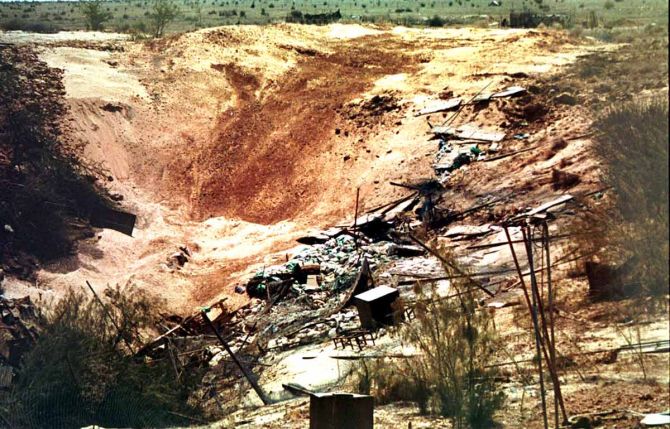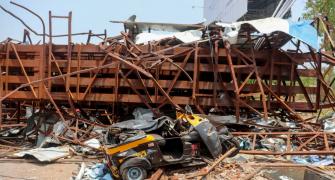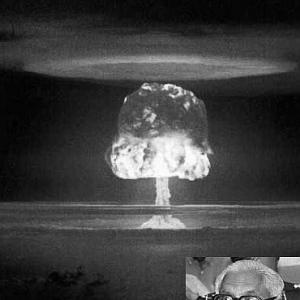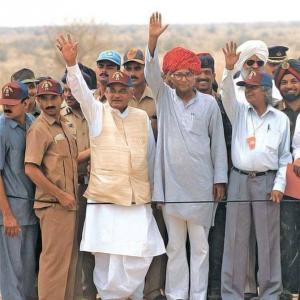Although the credit for acquiring the technological skill must be given to India's outstanding nuclear scientists, the decision to go nuclear was a political one that entailed clarity of vision, courage and resolve, points out Rup Narayan Das.

Between May 11 to 13, 1998, India conducted a series of three underground Peaceful Nuclear Explosions, proclaiming its status as a potential nuclear State undeterred by the demarche of the West and defying the threats of sanctions.
Although the credit for acquiring the technological skill and wherewithal must be given to India's outstanding nuclear scientists starting from Dr Homi Bhabha to the dedicated team of nuclear scientists at the BARC, the decision to go nuclear was a political one that entailed clarity of vision, courage and resolve.
The credit must be given to then prime minister Indira Gandhi in 1974 and then PM Atal Bihari Vajpayee in 1998.
The government of the day all these years since 1974 till 1998 never felt it expedient to demonstrate to the world India's resolve to go nuclear in deference to the dictate of the West and pursued nuclear disarmament despite the deafening silence of nuclear states who repeatedly ignored India's legitimate security interest.
India's position was that in the absence of universal and non-discriminatory disarmament, the country could not accept a regime that creates an arbitrary division between nuclear haves and have-nots.
India held that it is the sovereign right of every nation to make a judgement regarding its supreme national interests and exercise its sovereign choice.
India's decision not to sign the Nuclear Non-Proliferation Treaty in 1967 was supported by Parliament.
Despite India's abhorrence of weaponisation of nuclear energy, India enacted the Atomic Act in 1948 which created the edifice of the Atomic Energy Commission and related research infrastructures which developed the potential dual-use capability.
Indian nuclear scientists developed the nuclear technology on their own without any outside support.
India's calibrated response to the NPT was articulated by then prime minister Indira Gandhi in the Lok Sabha on April 5, 1968.
She assured the House that 'We shall be guided entirely by our self-enlightenment and consideration of national security.'
She highlighted the shortcomings of the NPT whilst re-emphasising the country's commitment to nuclear disarmament.
She informed the House 'that not signing the Treaty may bring the nation many difficulties. It may mean the stoppage of aid and the stoppage of help.
'Since we are taking this decision together, we must all be together in facing its consequences.'
The USA was hostile to India in the 1971 War and had deployed the Seventh Fleet in the Bay of Bengal.
India had very little choice but to go nuclear in this situation amidst the China-Pakistan axis and threat from the US.
It was against this backdrop that India conducted the Peaceful Nuclear Explosion (PNE) in Pokhran in Rajasthan in 1974.
After India's nuclear test, a global regime of nuclear embargo was clamped around India.
The US also created the Nuclear Suppliers Group -- NSG -- to punish India. Forced by the circumstances India exercised its nuclear option and announced itself as a nuclear weapon State.
The US strongly reacted to India's tests and threatened to impose sanctions and cut off foreign aid and reliable supply of nuclear fuel if international safeguards were not applied.
India felt it has been subjected to standards which were not applied to China and Israel.
In fact, in 1974, President Gerald Ford withheld shipments to the Tarapur nuclear plant at Trombay until it was determined that American materials were not used in the detonation.
When then prime minister Moraji Desai of the short-lived Janata government promised that India would not develop nuclear weapons or conduct further tests, the US Congress repealed the prohibition, and aid to India resumed.
The end of the Cold War marked a watershed in the history of the 20th century. While it transformed the political landscape of Europe. It did little to address India's security concerns.
The USA was indifferent to India's concerns.
It was against this background of the double standard of the West and their indifference and insensitivity to India's security imperatives that then prime minister Atal Bihari Vajpayee's government decided to conduct the underground nuclear explosion in May 1998.

In a letter to President Bill Clinton which was published in The New York Times on 13th May 1998, Prime Minister Atal Bihari Vajpayee explained the rationale for the underground nuclear test.
'We have an overt nuclear State on our border, a State which committed armed aggression against India in 1962. Although our relations with that country have improved in the last decade or so, an atmosphere of distrust persists mainly due to the unresolved border problem,' Vajpayee wrote.
'To add to the distrust that country has materially helped another neighbour ours to become a covert nuclear test.'
Clinton reacted strongly to the news of the tests, avowing that 'India was on the wrong side of the history'. India was subjected to severe criticism by the West since the tests came after decades of India's vociferous advocacy of nuclear disarmament and the need for a nuclear-free world.
There was criticism that the tests were a straightforward case of India's hypocrisy and deviousness.
Clinton announced the imposition of economic sanctions on India. He also invoked the Glenn Amendment of the Arms Control Act which imposed extensive economic and military sanctions on both India and Pakistan.
India-US relations were, however, transformed to a comprehensive global strategic partnership afterwards paving the path for the India-US nuclear deal.
India-US Nuclear Deal
Another milestone in India's nuclear policy was the India-US Nuclear Deal announced by President George W Bush in July 2005 during then prime minister Dr Manmohan Singh's visit to Washington, DC.
In 2008 the deal, called the 123 Agreement, was formally signed by both sides. The nuclear treaty was aimed at ending India's nuclear isolation and nuclear apartheid.
India was denied high technology in the field of nuclear energy. The India-US nuclear treaty envisaged enabling India to import nuclear reactors from France, Russia, Canada and other countries.
It was also argued that the deal would enable India to have access to nuclear fuel from these countries. It had two broad objectives: India's strategic objective and providing energy security.

Heated debate in Parliament
The India-US nuclear deal triggered a stand-off between the ruling United Progressive Alliance government led by Dr Manmohan Singh and the Opposition including the left parties on whose support the UPA government was dependent.
The Left bloc felt that India was bowing before the USA. The Communists were concerned that the US would bully India into submission with threats and warnings.
The BJP was expedient, given that it was the Vajpayee government that initiated a dialogue with the US to get this very result.
In Parliament, Dr Singh tried to allay the anxiety of the Opposition, particularly the Left parties, that there was a 'secret deal' behind the public one, and denied that India was entering into a military alliance with the US against China.
He also assured Parliament that the negotiation with the US to work out the separation plan and other details would not hurt India's strategic programme.

Separation Plan
A great challenge for the India-US nuclear deal was the separation plan that the two sides negotiated between August 2005 and February 2006.
India had a total of 22 nuclear plants in 2005. The US suggested that India could classify four of these as required for its strategic programme.
India wanted eight of these 22, including two research reactors, classified as part of its strategic programme, with 14 separated as civilian facilities that would be brought under International Atomic Energy safeguards.
Outlining some salient features of the Separation Plan, Dr Singh, in a statement made in the Lok Sabha on March 7, 2007, said, '...that the Separation Plan will not adversely affect our strategic programme. There will be no capping of our strategic programme, and the separation plan ensures adequacy of fissile material and other inputs to meet the current and future requirements of our strategic programme, based on our assessment of the threat scenarios.
'No constraint has been placed on our right to construct new facilities for strategic purposes.
'The integrity of our nuclear doctrine and our ability to sustain a minimum credible nuclear deterrent is adequately protected.
'Our nuclear policy will continue to be guided by the principles of restraint and responsibility.'
'The Separation Plan does not come in the way of the integrity of our three stage nuclear programme, including the future use of our thorium reserves,' Dr Singh further assured the House.
The India-US nuclear deal polarised Indian politics to such an extent that it forced the UPA coalition government to seek a Vote of Confidence in the Lok Sabha on July 21, 2008 following the withdrawal of support by the Left on the issue of the government's initiative of seeking international cooperation in the development of civil nuclear energy.
The government, however, survived.

Civil Liability for Nuclear Liability Damage Act 2010
The Civil Liability for Nuclear Liability Damage (CLND) Act 2010, a legislation that was enacted by Parliament to ensure a speedy compensation mechanism for victims in case of a nuclear accident can be singled out as the biggest reason for the stalemate on the engagement between India and the US. Some provisions of the Act were perceived as the hindrance for the supply of equipment by the US reactor vendors and sub-suppliers.
The significance of the Civil Nuclear Liability Act can be hardly overemphasised in the backdrop of India's disastrous experience with the Union Carbide gas leak tragedy in Bhopal.
The Act envisaged prompt payment of compensation to victims in the case of an unforeseen nuclear accident.
In recent years a lot of ground has been covered in India's march towards nuclear status. The country has acquired the nuclear triad status with formidable Agni-V missile with MIRV technology, not to mention the BrahMos missile which India has now exported to the Philippines.
India's message is peace is contingent on hard power borrowing from the Gandhian dictum that non-violence is not the weapon of the weak, but the strong.
Dr Rup Narayan Das is a former senior fellow of the Manohar Parrikar Institute for Defence Studies and Analyses and also Indian Council of Social Science Research. Views expressed are personal.
Feature Presentation: Aslam Hunani/Rediff.com










